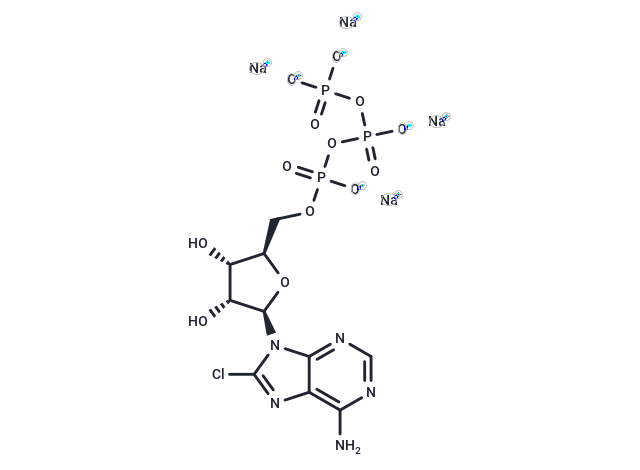 Your shopping cart is currently empty
Your shopping cart is currently empty

8-Chloroadenosine-5'-triphosphate (8-chloro ATP), a potent metabolite of the anticancer agent 8-chloro cyclic AMP (cAMP) and a nucleotide derivative, is produced through the biotransformation of 8-chloro cAMP into 8-chloroadenosine, followed by mono- and diphosphate intermediates. Accumulating for up to 12 hours after the administration of 8-chloro cAMP or 8-chloroadenosine, 8-chloro ATP inhibits cell growth, diminishes endogenous ATP levels, and reduces RNA synthesis without affecting DNA synthesis in multiple myeloma cells derived from patients. Moreover, it obstructs topoisomerase II-α-mediated relaxation of supercoiled pUC19 DNA at concentrations ranging from 1.5 to 8 mM and decreases topoisomerase II-α-enhanced ATP hydrolysis by 50% at a concentration of 1 mM in K562 human myelocytic leukemia cells.

| Pack Size | Price | USA Warehouse | Global Warehouse | Quantity |
|---|---|---|---|---|
| 2700 μg | $635 | 35 days | 35 days |
| Description | 8-Chloroadenosine-5'-triphosphate (8-chloro ATP), a potent metabolite of the anticancer agent 8-chloro cyclic AMP (cAMP) and a nucleotide derivative, is produced through the biotransformation of 8-chloro cAMP into 8-chloroadenosine, followed by mono- and diphosphate intermediates. Accumulating for up to 12 hours after the administration of 8-chloro cAMP or 8-chloroadenosine, 8-chloro ATP inhibits cell growth, diminishes endogenous ATP levels, and reduces RNA synthesis without affecting DNA synthesis in multiple myeloma cells derived from patients. Moreover, it obstructs topoisomerase II-α-mediated relaxation of supercoiled pUC19 DNA at concentrations ranging from 1.5 to 8 mM and decreases topoisomerase II-α-enhanced ATP hydrolysis by 50% at a concentration of 1 mM in K562 human myelocytic leukemia cells. |
| Synonyms | 8-chloro ATP |
| Molecular Weight | 629.55 |
| Formula | C10H11ClN5O13P3.4Na |
| Cas No. | 793671-47-3 |
| Smiles | O[C@@H]1[C@@H](COP(OP(OP([O-])([O-])=O)([O-])=O)([O-])=O)O[C@@H](N2C3=NC=NC(N)=C3N=C2Cl)[C@@H]1O.[Na+].[Na+].[Na+].[Na+] |
| Storage | Powder: -20°C for 3 years | In solvent: -80°C for 1 year | Shipping with blue ice/Shipping at ambient temperature. |
| Solubility Information | H2O: Soluble |
| Size | Quantity | Unit Price | Amount | Operation |
|---|

Copyright © 2015-2026 TargetMol Chemicals Inc. All Rights Reserved.